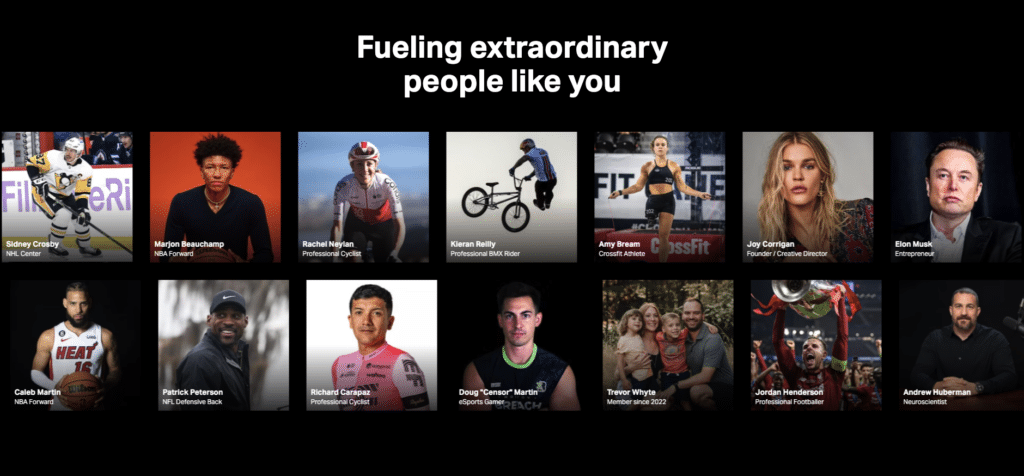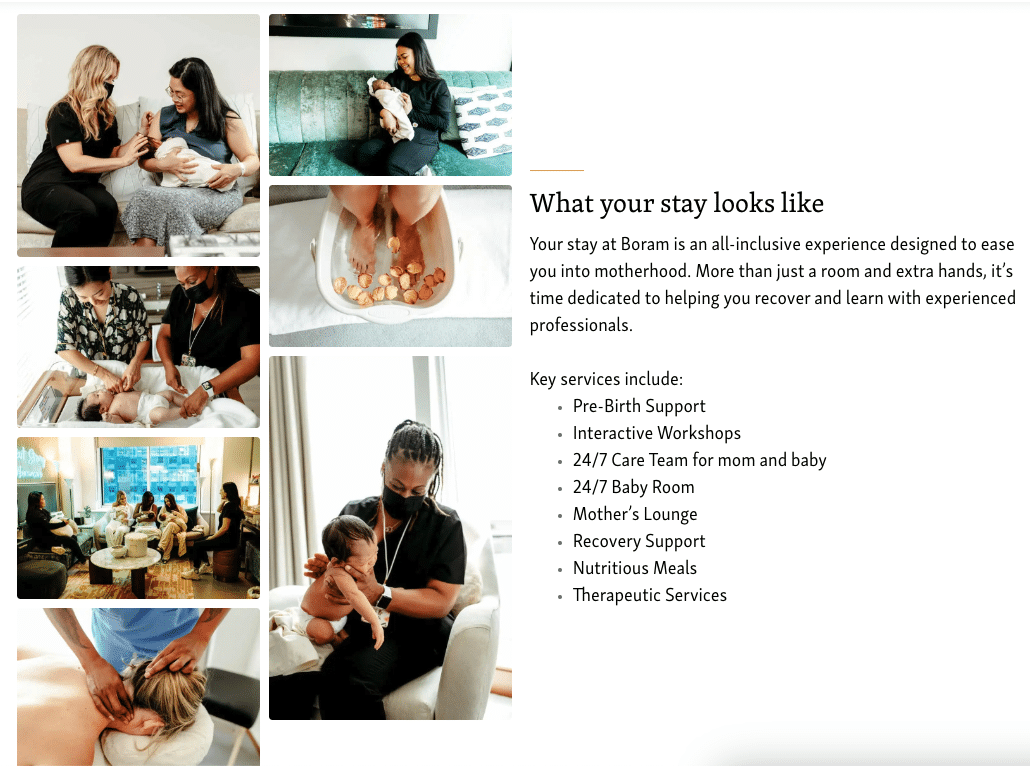Brands exist in the space between how people perceive themselves and how they behave.
Our self-perceptions are the building blocks of our reality, and when the way we act doesn’t measure up to who we believe we are, it feels very uncomfortable. Oftentimes it’s the kind of pain that we will do nearly anything to resolve.
All brands are vehicles for closing this gap. The bigger the gap the bigger the cognitive dissonance, and the bigger the opportunity for the brand.
Eight Sleep is a premium bed cooling and sleep monitoring system made for professional athletes, but that’s not their core audience.
Think of the average person who has bought into hustle culture, or is on the wellness fastrack, or is an entrepreneur, or generally sees themselves as a leader. Their self-perceptions hinge on their ability to be productive, and if those people struggle and fail to get out of bed at 5am over and over again in order to have a productive day, or if they struggle to focus, or if they don’t treat their bodies like the hardware to their mental software, then their identity is threatened.
These people are not the elite athletes that Eight Sleep was designed for, but they are the performance-minded people that Eight Sleep’s brand captures. They pay for Eight Sleep not only in high cost, but also in the time it takes to rearrange their bedrooms and the commitment it takes to learn and use the app over time.
People pay these high costs because they are not merely solving for sleep. They are solving for their cognitive dissonance. The one thing they want (or perhaps need) more than rest is to feel like they are performing at a level that matches their self-perceptions.

Strong brands have cognitive dissonance at their core. They understand that while the product may solve a real-world problem, the brand is solving a much more valuable identity problem.
Social psychology identifies three ways to solve for cognitive dissonance. Each pathway gets us from a state of high dissonance (discomfort and pain), to a state of lower dissonance (comfort, ease). Each one speaks to different user needs in a market, and has its own challenges and opportunities.
1. Change belief – Change one’s beliefs to be more aligned with one’s actions.
2. Change action – Change one’s actions to be more aligned with one’s beliefs.
3. Change action perception – Rationalize or justify the difference between one’s beliefs and one’s actions.
Each of these three pathways shrinks the gap between someone’s identity and behaviors, and thus lowers their cognitive dissonance.
However, I’ve seen a fourth pathway emerge that not only works, but is indicative of where successful brands are headed over the next few years.
4. Adapt action – Change the outcomes of one’s actions to be more aligned with one’s beliefs.
In this fourth pathway, people get to enjoy lowered cognitive dissonance without the labor of changing their beliefs or actions, nor the mental gymnastics of changing the perception of their actions.
Each pathway is uniquely suited to a certain kind of market problem, and a certain kind of solution.

Most brands fail to recognize the true cognitive dissonance they are up against, and then either take the wrong pathway or take none at all. For brand owners, CEOs and investors, these pathways also reveal the durability of a brand, namely its ability to continue serving a significant need for customers even as competitor brands put pressure on the marketplace.
You can study your user inside and out, but if you don’t know the cognitive dissonance that shapes them, then you don’t know how to build a brand that will serve them.
Change Belief
Many brands are limited by a pervading belief in the minds of their users. A bias like “Only rich people buy art” or “Vegans are weak” will keep someone in a high state of dissonance when in fact they do appreciate fine artwork or care about their health. These biases will also keep them from buying the painting or trying the plant-based restaurant.
Dissonance that comes from biases oftentimes explains why your audience may have the means and resources to convert, but instead chooses to spend that money somewhere else. They’re usually spending it where they feel less cognitive dissonance (in this case it might be new furniture or the gym).
The unique thing about this specific pathway for relieving cognitive dissonance is that new information or ideas, education and exposure are not what change beliefs. To change our beliefs we must change our identities.
People resist changing their beliefs because in some part, it means losing a sense of self. Belief and identity are so deeply intertwined that when people change their religions, their partners, their jobs, their diets or their politics, they often describe the shift as leaving an old version of themselves behind.
We can’t change our minds until we are able to see ourselves as new people. We have to be able to grasp what this new identity looks, feels and thinks like.
In their “In Case of Adventure” series, Rivian is selling a car, but also selling a new identity. When people wonder to themselves, “Who buys a Rivian?” the answer will be clear: the urban adventurer. This identity clearly pops up in Rivian’s content, testimonials, gear shop and PR.
Rivian’s “In Case Of Adventure” series, 7/25/2023
It’s a move straight out of the premium vehicle playbook. Porche’s home & lifestyle line, Mercedes-Benz’s coffee lounges and Harley Davidson’s community pilgrimages (which I’ve written about before) are all methods for signaling the identity of the driver.
When you give people a sense of new identity, it’s easier for them to drop their biases and change their beliefs. They can be more certain about who they are and how they should move through the world.
I’ve seen this dissonance pathway a lot in B2B as well. In our research with high performing B2B salespeople over the years, we’ve seen brands like Gong emerge as preferred platforms not because of their technology (in this case a sales intelligence platform) but because of how they celebrate a new identity of the salesperson. Gong exalts salespeople as bold and passionate heroes. The Gong user has a clear identity.
This pathway to solving cognitive dissonance is well suited for brands that face strong biases, which may sound like “A person like me can’t do things like that” or “People who do that look like this.”
These biases explain why many food and foodtech brands have failed in the market, despite innovative products. Surprisingly, food is highly personal and identity driven. What we eat is a big part of how we see ourselves in the world.
Change Action
When a category of users can be characterized by having fear, apprehension or even shame that holds them back from doing something, there is likely a pent up demand for new behavior.
People who are stuck in this form of cognitive dissonance don’t necessarily need to change their beliefs. Instead, they need to change their actions, and that typically only happens when there is enough psychological safety to try something new.
The explosion of kidult play — adults playing with kids toys — is a great example of brands creating enough psychological safety to change a behavior that has been historically limited by shame or fear of judgment. Brands like Lego have created inviting, thoughtful and safe environments for adults to engage in play — so much so that adult fandoms are propelling Lego’s revenue and market to unprecedented levels.
Adult-themed product extensions, research on the adult-child relationship in play, and deep adult Lego communities and conventions give this consumer the psychological safety they need to turn what may be considered a childish hobby into a valid and rewarding adult experience.
Today’s adult Happy Meals, adults-only bouncy houses and the Barbie movie were perhaps a natural response to the joyless years of Covid, but they are also all branded efforts to make play more of a safe zone for adults.
There are other brands, however, that have failed to create the same kind of psychological safety for their adult fans and are likely missing out on a valuable segment. In a recent Washington Post article, a 27-year-old referred to as “Nick” divulged his obsession with Squishmallows (which are round pastel-colored plushies) on condition of anonymity because he was fearful of losing his job if his employer found out. Meanwhile, a Today Show post about the kidult craze drew especially harsh criticism that revealed just how severely our culture continues to judge adults who play with toys.

The cognitive dissonance gap may be narrowed in Lego’s corner of the market, but it is wide and thriving in other areas where shame still overshadows play for adults. That is a clear opportunity for brands who are willing to invest in branding, positioning and product innovation that creates psychological safety for their users.
Over in the sexual health category, Dame creates psychological safety through high quality product design and calming, artistic visual branding that stands in great contrast to the salacious and bawdy brands of most competitor companies.
The repeated message of “for women by women” also creates a kind of psychological safety that is sorely missing from this market — one that removes the male gaze from the conversation. Dame is a safe space for women to explore desire without the shame, stigma or limiting beliefs that usually govern their shopping habits. However, even more importantly, Dame matches the self-perception of a huge user base that rarely sees themselves reflected in other brands.
Change Action Perception
There are times when the barriers to changing action are so high, even psychological safety won’t likely work. In those instances, changing the perception of the action may be the strongest way forward.
Parents, especially new mothers, are a prime example of what happens when there is high dissonance between how someone perceives their identity, and the nearly impossible actions it will take to live up to that perception.
New mothers have new identities, usually shaped and informed by shiny Instagram mommy influencers and long-held narratives about a mother’s role in the world. But I have seen in my research with parenting brands over the last 10 years that the vast majority of these same mothers simply cannot make their actions match this new identity, no matter how hard they try.
In early motherhood, women are reborn themselves. With a new baby and a new perspective, they often start new businesses or careers. This generation of mothers is also the first to not look to their own mothers for guidance on the motherhood journey, opting instead to educate themselves and form their own intuition (no small feat). They are also highly concerned with reversing the parenting mistakes they experienced as children. In short, new mothers today want to grow themselves as they grow their families.
But the truth of the matter is that they do not have the resources. They do not have the tribe, the money, the support systems or the time to live into this exceptionally demanding new identity. They will have to make heart-wrenching compromises between themselves and their babies nearly every single day, and in this quiet suffering, they further cement the dissonance they are trying to run away from.
The right path forward for brands in this space is to change the perception of the action, and in order to do that, brands must create a movement and/ or a community.
Boram is an interesting new concept in early motherhood care that changes the script around parenting. Described as a ‘postnatal retreat’, the all-inclusive center offers 5-star accommodations, a 24/7 care team of doctors and clinicians who help people ease into motherhood while teaching them the mountain of skills and knowledge they will need when taking the baby home. This all happens within a routine of nourishing chef-prepared meals, massage services, night nurse coverage and recovery support.

The vast majority of mothers who don’t make it to Boram will not experience a single one of these things in the usual postnatal experience.
Boram isn’t about luxuries. It’s about honoring the integrity of a woman who has just given birth. It may not be for everyone, but it is possibly the beginning of a new movement that centers the mother and her health, surrounding her with a community of care.
In this experience, mothers who want to live up to their new self-perceptions are not forced into failure. They are lifted into possibility. The cognitive dissonance between who they want to be and their actions toward that identity is greatly lowered in the crucial, early days postpartum.
While mothers may be a self-aware group, an important thing to remember with this pathway is that the user in other categories may not always understand, or even be aware of, their hidden desires. Norms and social conditioning can make them out of touch with their own needs, despite how high the underlying cognitive dissonance may be. You might even find that the higher the cognitive dissonance, the greater the self-denial.
If you do discover a high, invisible dissonance, community is especially important. Communities have specific rules, which I have written about before, but the most important rule is to know why you gather.
A former client in the bath and candle space had a unique user base of middle-America women that were especially obsessed with the company’s jewel candles: large theme-scented candles that melted down over a number of hours to reveal a piece of jewelry hidden inside. Users loved the scents and candle jars, and really loved collecting the silver gemstone rings, earrings and necklaces that were buried under the wax.
It was always assumed that these users saw their candles as a luxury, or fun pastime, but as we got deeper into our conversations, we realized that there were a lot of strong emotions tied up with the experience. Users would save for weeks to buy special drops, with the company seeing a spike in sales on payday every month. People traded candles and jewels, traveled with other fans, and most interestingly would use the candles while taking a bath in a locked bathroom.
What we came to learn was that many of their customers were dealing with incredibly stressful events, either from physical disability, stressful jobs, or personal circumstances. They may have thought the candles were frivolous purchases, but they used them very seriously. They saw them as stress-relieving tools that made them happy, and after a scented candle-lit bath, also made them feel whole again. It was the most sincere form of self-care: finding a small way to care for their own emotional needs.
But when we asked them directly about it, the idea of candles as self-care seemed completely alien. Self-care was something they felt they had no business investing in, and yet, that was exactly what they were doing.
We gently built the community around the concept of self-care and created new products with a self-care slant, while still maintaining the whimsy of the original brand. The goal was to not let people think this was a frivolous purchase (which caused their dissonance) and help them see that this bath time was a fundamental part of being mentally and emotionally fulfilled. It reduced the invisible dissonance that users felt every time they felt strongly compelled to buy, but couldn’t justify why.
It also helped center the company around a deep and meaningful “why”.
Adapt Action
While changing action and belief are valid pathways to success, it’s also important to consider how the customer journey around everything is evolving. According to a new Edelman Trust Barometer report, Gen Z is upending the purchase funnel in surprising ways (emphasis added below):
Gen Z’s true relationship with brands often begins at purchase…”Our data showed that that purchase is not an end point. It’s the starting point… According to the study, 78% of Gen Z respondents say they “uncover things that attract me and make me loyal to a brand after my first purchase,” with 50% saying they do most of their brand research after they buy.
People are increasingly creating brand relationships after the fact of conversion. That means you may not have much time to change belief or action beforehand.
In that case, adapting action may be the best pathway forward.
Instead of changing people’s beliefs, or changing their actions or perceptions of those actions, you must find a way to let them engage in the same behaviors, but with outcomes that are more aligned with the identities they hold for themselves.
Adapting action means people make little or no change to their beliefs and behaviors, but enjoy a different outcome that is more aligned with their identities.
Sollis Health is a 24/7 members-only medical center. They remove a lot of the friction that comes in the usual doctor’s office or urgent care visit, and replace it with comforting experiences. Members enjoy a private space where medical care is the way it should be: highly attentive, calming in nature, extremely well staffed and resourced, and designed to make patients feel like VIPs.

But people don’t pay annual memberships ranging from $3,500 to $6,000 for convenience and amenities alone. What makes Sollis a strong brand is the hidden cognitive dissonance it aims to ease.
Throughout Sollis’ brand, the big promise is clarity and handholding. Sollis members feel like a unified team of elite professionals is actively watching over the health of them and their families. They have a sense of clarity in their medical care, and they feel confident in the condition of their health.
People generally want to believe that they are responsible in managing their wellbeing. They want to believe they eat right, exercise, get their annual exams, stay on top of blood tests and so on. But that doesn’t square with the fact that so many of us avoid the doctor’s office or the hospital, delaying important visits and skipping treatments altogether.
Why do we hate the doctor’s office or hospital so much? Because it tells the opposite story of responsible wellbeing. Oftentimes, conversations with doctors and nurses leave us with more questions than answers. Practitioners don’t speak to each other and we nervously work to make sure each new doctor has our history and up-to-date records.
The experience, especially if you have a significant condition to deal with, feels highly disempowering. When we go to these places, we do not get to act like the health-forward people we think we are. Instead we leave aggravated, feeling bad about ourselves, and anxious that our behavior does not live up to our self-perception.
And this is the genius of Sollis. Instead of asking more of us (like the empowered patient movement), or asking us to do something different (like functional medicine), Sollis allows us to keep the same behavior but experience a very different outcome. We simply go to the doctor’s office and we get to be the responsible, health-forward people we believe we are. Everything about Sollis reinforces this identity.
Adapting action is usually the quickest way to close the dissonance gap because it lowers or erases the bar to action.
The brands that succeed in this pathway oftentimes look like crossovers. They borrow from complementary categories to create new norms in how people behave, and what they expect the outcomes to be.
Education is a notoriously tough industry to crack into, but edutainment is a crossover that both lowers the barrier to action and changes the outcomes to be more in line with our self-perceptions.
While platforms like Masterclass and Patreon made great strides in this direction, TikTok has mastered it with their education content. There are many stats that show just how powerful TikTok is in edutainment, including the fact that a surprising 51% of college students use it for homework help.
Education on TikTok is a crossover between intimate conversations with your favorite parasocial friends and bite sized insights that pique your interest in things you may not have cared about otherwise.
We can continue our deeply ingrained action (scrolling on a phone watching 30-second bits of content), but enjoy a much more identity-aligned outcome (valuable learning).
I believe the adapt action pathway will be one of the most successful and defensible paths for brands over the next few years because as the world becomes more noisy and culture becomes more fragmented, we will have less and less time to do the hard work required of the other 3 paths.
Adapt action bundles brand defensibility with product defensibility in a way that we rarely see in the marketplace, creating new spaces and norms for users. If you can cheat cognitive dissonance so that the same actions produce different results, you can win over a much wider audience.
While it may be tempting to choose a pathway that seems obvious or easy, or to choose adapt action because it offers lucrative opportunity, you must always choose the one that is best suited to your problem.
In fact, you don’t usually get to choose the path you must take. Given that the problem you are solving, the user you are solving for and the pressures of the market are not in your control, the path will usually choose you.
Step away from your product and instead look at the motivations of your user. Where is there a mismatch between who they are and who they believe to be? Where do they suffer the pain of not meeting their own expectations? When it comes to your category, product or service, who do they see themselves as, and how do they work against that image? Find the path that is required of your brand.
We live with dissonance everyday, and the best brands understand that. They use it not only to shape their branding, but also their products, services and user experiences.
Each pathway, when properly explored, will reveal new opportunities throughout the business and the marketplace. Your reach, engagement and defensibility will all be more impactful.
It’s a great path to innovation, while staying true to the people you’re looking to serve.
[This piece is a sequel to an earlier piece I wrote about cognitive dissonance called The Cognitive Dissonance Hiding Behind Strong Brands]




